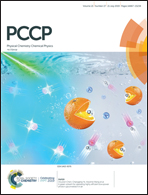Improving the accuracy of solid-state nuclear magnetic resonance chemical shift prediction with a simple molecular correction†
Abstract
A fast, straightforward method for computing NMR chemical shieldings of crystalline solids is proposed. The method combines the advantages of both conventional approaches: periodic calculations using plane-wave basis sets and molecular computational approaches. The periodic calculations capture the periodic nature of crystalline solids, but the computational level of the electronic structure calculation is limited to general-gradient-approximation (GGA) density functionals. It is demonstrated that a correction to the GGA result calculated on an isolated molecule at a higher level of theory significantly improves the correlations between experimental and calculated chemical shifts while adding almost no additional computational cost. Corrections calculated with a hybrid density functional improved the accuracy of 13C, 15N and 17O chemical shift predictions significantly and allowed identifying errors in previously published experimental data. Applications of the approach to crystalline isocytosine, methacrylamide, and testosterone are presented.



 Please wait while we load your content...
Please wait while we load your content...
